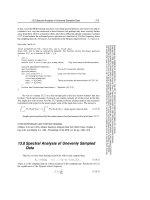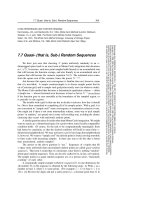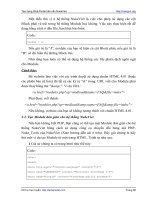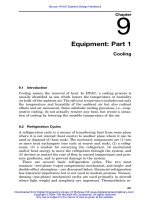Random Numbers part 9
Bạn đang xem bản rút gọn của tài liệu. Xem và tải ngay bản đầy đủ của tài liệu tại đây (206.02 KB, 13 trang )
316
Chapter 7. Random Numbers
Sample page from NUMERICAL RECIPES IN C: THE ART OF SCIENTIFIC COMPUTING (ISBN 0-521-43108-5)
Copyright (C) 1988-1992 by Cambridge University Press.Programs Copyright (C) 1988-1992 by Numerical Recipes Software.
Permission is granted for internet users to make one paper copy for their own personal use. Further reproduction, or any copying of machine-
readable files (including this one) to any servercomputer, is strictly prohibited. To order Numerical Recipes books,diskettes, or CDROMs
visit website or call 1-800-872-7423 (North America only),or send email to (outside North America).
7.8 Adaptive and Recursive Monte Carlo
Methods
This section discusses more advanced techniques of Monte Carlo integration. As
examples of the use of these techniques, we include two rather different, fairly sophisticated,
multidimensional Monte Carlo codes: vegas
[1,2]
,andmiser
[3]
. The techniques that we
discuss all fall under the general rubric of reduction of variance (§7.6), but are otherwise
quite distinct.
Importance Sampling
The use of importance sampling was already implicit in equations (7.6.6) and (7.6.7).
We now return to it in a slightly more formal way. Suppose that an integrand f can be written
as the product of a function h that is almost constant times another, positive, function g.Then
its integral over a multidimensional volume V is
fdV =
(f/g)gdV =
hgdV (7.8.1)
In equation (7.6.7) we interpreted equation (7.8.1) as suggesting a change of variable to
G, the indefinite integral of g.ThatmadegdV a perfect differential. We then proceeded
to use the basic theorem of Monte Carlo integration, equation (7.6.1). A more general
interpretation of equation (7.8.1) is that we can integrate f by instead sampling h — not,
however, with uniform probability density dV , but rather with nonuniform density gdV .In
this second interpretation, the first interpretation follows as the special case, where the means
of generating the nonuniform sampling of gdV is via the transformation method, using the
indefinite integral G (see §7.2).
More directly, one can go back and generalize the basic theorem (7.6.1) to the case
of nonuniform sampling: Suppose that points x
i
are chosen within the volume V with a
probability density p satisfying
pdV =1 (7.8.2)
The generalized fundamental theorem is that the integral of any function f is estimated, using
N sample points x
i
,...,x
N
,by
I≡
fdV =
f
p
pdV ≈
f
p
±
f
2
/p
2
−f/p
2
N
(7.8.3)
where angle brackets denote arithmetic means over the N points, exactly as in equation
(7.6.2). As in equation (7.6.1), the “plus-or-minus” term is a one standard deviation error
estimate. Notice that equation (7.6.1) is in fact the special case of equation (7.8.3), with
p = constant =1/V .
What is the best choice for the sampling density p? Intuitively, we have already
seen that the idea is to make h = f/p as close to constant as possible. We can be more
rigorous by focusing on the numerator inside the square root in equation (7.8.3), which is
the variance per sample point. Both angle brackets are themselves Monte Carlo estimators
of integrals, so we can write
S ≡
f
2
p
2
−
f
p
2
≈
f
2
p
2
pdV −
f
p
pdV
2
=
f
2
p
dV −
fdV
2
(7.8.4)
We now find the optimal p subject to the constraint equation (7.8.2) by the functional variation
0=
δ
δp
f
2
p
dV −
fdV
2
+λ
pdV
(7.8.5)
7.8 Adaptive and Recursive Monte Carlo Methods
317
Sample page from NUMERICAL RECIPES IN C: THE ART OF SCIENTIFIC COMPUTING (ISBN 0-521-43108-5)
Copyright (C) 1988-1992 by Cambridge University Press.Programs Copyright (C) 1988-1992 by Numerical Recipes Software.
Permission is granted for internet users to make one paper copy for their own personal use. Further reproduction, or any copying of machine-
readable files (including this one) to any servercomputer, is strictly prohibited. To order Numerical Recipes books,diskettes, or CDROMs
visit website or call 1-800-872-7423 (North America only),or send email to (outside North America).
with λ a Lagrange multiplier. Note that the middle term does not depend on p. The variation
(which comes inside the integrals) gives 0=−f
2
/p
2
+ λ or
p =
|f|
√
λ
=
|f|
|f| dV
(7.8.6)
where λ has been chosen to enforce the constraint (7.8.2).
If f has one sign in the region of integration, then we get the obvious result that the
optimal choice of p — if one can figure out a practical way of effecting the sampling — is
that it be proportional to |f|. Then the variance is reduced to zero. Not so obvious, but seen
to be true, is the fact that p ∝|f|is optimal even if f takes on both signs. In that case the
variance per sample point (from equations 7.8.4 and 7.8.6) is
S = S
optimal
=
|f| dV
2
−
fdV
2
(7.8.7)
One curiosity is that one can add a constant to the integrand to make it all of one sign,
since this changes the integral by a known amount, constant× V . Then, the optimal choice
of p always gives zero variance, that is, a perfectly accurate integral! The resolution of
this seeming paradox (already mentioned at the end of §7.6) is that perfect knowledge of p
in equation (7.8.6) requires perfect knowledge of
|f|dV , which is tantamount to already
knowing the integral you are trying to compute!
If your function f takes on a known constant value in most of the volume V ,itis
certainly a good idea to add a constant so as to make that value zero. Having done that, the
accuracy attainable by importance sampling depends in practice not on how small equation
(7.8.7) is, but rather on how small is equation (7.8.4) for an implementable p, likely only a
crude approximation to the ideal.
Stratified Sampling
Theideaofstratified sampling is quite different from importance sampling. Let us
expand our notation slightly and let f denote the true average of the function f over
the volume V (namely the integral divided by V ), while f denotes as before the simplest
(uniformly sampled) Monte Carlo estimator of that average:
f ≡
1
V
fdV f≡
1
N
i
f(x
i
)(7.8.8)
The variance of the estimator, Var (f), which measures the square of the error of the
Monte Carlo integration, is asymptotically related to the variance of the function, Var(f) ≡
f
2
− f
2
, by the relation
Var (f )=
Var (f )
N
(7.8.9)
(compare equation 7.6.1).
Suppose we divide the volume V into two equal, disjoint subvolumes, denoted a and b,
and sample N/2 points in each subvolume. Then another estimator for f , different from
equation (7.8.8), which we denote f
,is
f
≡
1
2
f
a
+f
b
(7.8.10)
in other words, the mean of the sample averages in the two half-regions. The variance of
estimator (7.8.10) is given by
Var
f
=
1
4
Var
f
a
+ Var
f
b
=
1
4
Var
a
(f )
N/2
+
Var
b
(f )
N/2
=
1
2N
[Var
a
(f )+Var
b
(f )]
(7.8.11)
318
Chapter 7. Random Numbers
Sample page from NUMERICAL RECIPES IN C: THE ART OF SCIENTIFIC COMPUTING (ISBN 0-521-43108-5)
Copyright (C) 1988-1992 by Cambridge University Press.Programs Copyright (C) 1988-1992 by Numerical Recipes Software.
Permission is granted for internet users to make one paper copy for their own personal use. Further reproduction, or any copying of machine-
readable files (including this one) to any servercomputer, is strictly prohibited. To order Numerical Recipes books,diskettes, or CDROMs
visit website or call 1-800-872-7423 (North America only),or send email to (outside North America).
Here Var
a
(f) denotes the variance of f in subregion a,thatis, f
2
a
−f
2
a
,and
correspondingly for b.
From the definitions already given, it is not difficult to prove the relation
Var (f )=
1
2
[Var
a
(f )+Var
b
(f )] +
1
4
( f
a
−f
b
)
2
(7.8.12)
(In physics, this formula for combining second moments is the “parallel axis theorem.”)
Comparing equations (7.8.9), (7.8.11), and (7.8.12), one sees that the stratified (into two
subvolumes) sampling gives a variance that is never larger than the simple Monte Carlo case
— and smaller whenever the means of the stratified samples, f
a
and f
b
, are different.
We have not yet exploited the possibility of sampling the two subvolumes with different
numbers of points, say N
a
in subregion a and N
b
≡ N − N
a
in subregion b. Let us do so
now. Then the variance of the estimator is
Var
f
=
1
4
Var
a
(f )
N
a
+
Var
b
(f )
N − N
a
(7.8.13)
which is minimized (one can easily verify) when
N
a
N
=
σ
a
σ
a
+ σ
b
(7.8.14)
Here we have adopted the shorthand notation σ
a
≡ [Var
a
(f )]
1/2
, and correspondingly for b.
If N
a
satisfies equation (7.8.14), then equation (7.8.13) reduces to
Var
f
=
(σ
a
+ σ
b
)
2
4N
(7.8.15)
Equation (7.8.15) reduces to equation (7.8.9) if Var (f )=Var
a
(f )=Var
b
(f ), in which case
stratifying the sample makes no difference.
A standard way to generalize the above result is to consider the volume V divided into
more than two equal subregions. One can readily obtain the result that the optimal allocation of
sample points among the regions is to have the number of points in each region j proportional
to σ
j
(that is, the square root of the variance of the function f in that subregion). In spaces
of high dimensionality (say d
>
∼
4) this is not in practice very useful, however. Dividing a
volume into K segments along each dimension implies K
d
subvolumes, typically much too
large a number when one contemplates estimating all the corresponding σ
j
’s.
Mixed Strategies
Importance sampling and stratified sampling seem, at first sight, inconsistent with each
other. The former concentrates sample points where the magnitude of the integrand |f| is
largest, that latter where the variance of f is largest. How can both be right?
The answer is that (like so much else in life) it all depends on what you know and how
well you know it. Importance sampling depends on already knowing some approximation to
your integral, so that you are able to generate random points x
i
with the desired probability
density p. To the extent that your p is not ideal, you are left with an error that decreases
only as N
−1/2
. Things are particularly bad if your p is far from ideal in a region where the
integrand f is changing rapidly, since then the sampled function h = f/p will have a large
variance. Importance sampling works by smoothing the values of the sampled function h,
and is effective only to the extent that you succeed in this.
Stratified sampling, by contrast, does not necessarily require that you know anything
about f. Stratified sampling works by smoothing out the fluctuations of the number of points
in subregions, not by smoothing the values of the points. The simplest stratified strategy,
dividing V into N equal subregions and choosing one point randomly in each subregion,
already gives a method whose error decreases asymptotically as N
−1
, much faster than
N
−1/2
. (Note that quasi-random numbers,§7.7, are another way of smoothing fluctuations in
the density of points, giving nearly as good a result as the “blind” stratification strategy.)
However, “asymptotically” is an important caveat: For example, if the integrand is
negligible in all but a single subregion, then the resulting one-sample integration is all but
7.8 Adaptive and Recursive Monte Carlo Methods
319
Sample page from NUMERICAL RECIPES IN C: THE ART OF SCIENTIFIC COMPUTING (ISBN 0-521-43108-5)
Copyright (C) 1988-1992 by Cambridge University Press.Programs Copyright (C) 1988-1992 by Numerical Recipes Software.
Permission is granted for internet users to make one paper copy for their own personal use. Further reproduction, or any copying of machine-
readable files (including this one) to any servercomputer, is strictly prohibited. To order Numerical Recipes books,diskettes, or CDROMs
visit website or call 1-800-872-7423 (North America only),or send email to (outside North America).
useless. Information, even very crude, allowing importance sampling to put many points in
the active subregion would be much better than blind stratified sampling.
Stratified sampling really comes into its own if you have some way of estimating the
variances, so that you can put unequalnumbers of points in different subregions, according to
(7.8.14) or its generalizations, and if you can find a way of dividing a region into a practical
number of subregions (notably not K
d
with large dimension d), while yet significantly
reducing the variance of the function in each subregion compared to its variance in the full
volume. Doing this requires a lot of knowledge about f, though different knowledge from
what is required for importance sampling.
In practice, importance sampling and stratified sampling are not incompatible. In many,
if not most, cases of interest, the integrand f is small everywhere in V except for a small
fractional volume of “active regions.” In these regions the magnitude of |f| and the standard
deviation σ =[Var (f )]
1/2
are comparable in size, so both techniques will give about the
same concentration of points. In more sophisticated implementations, it is also possible to
“nest” the two techniques, so that (e.g.) importance sampling on a crude grid is followed
by stratification within each grid cell.
Adaptive Monte Carlo: VEGAS
The VEGAS algorithm, invented by Peter Lepage
[1,2]
, is widely used for multidimen-
sional integrals that occur in elementary particle physics. VEGAS is primarily based on
importance sampling, but it also does some stratified sampling if the dimension d is small
enough to avoid K
d
explosion (specifically, if (K/2)
d
<N/2, with N the number of sample
points). The basic technique for importance sampling in VEGAS is to construct, adaptively,
a multidimensional weight function g that is separable,
p ∝ g(x,y,z,...)=g
x
(x)g
y
(y)g
z
(z)... (7.8.16)
Such a function avoids the K
d
explosion in two ways: (i) It can be stored in the computer
as d separate one-dimensional functions, each defined by K tabulated values, say — so that
K × d replaces K
d
. (ii) It can be sampled as a probability density by consecutively sampling
the d one-dimensional functions to obtain coordinate vector components (x,y,z,...).
The optimal separable weight function can be shown to be
[1]
g
x
(x) ∝
dy
dz...
f
2
(x,y,z,...)
g
y
(y)g
z
(z)...
1/2
(7.8.17)
(and correspondingly for y,z,...). Notice that this reduces to g ∝|f|(7.8.6) in one
dimension. Equation (7.8.17) immediately suggests VEGAS’ adaptive strategy: Given a
set of g-functions (initially all constant, say), one samples the function f, accumulating not
only the overall estimator of the integral, but also the Kd estimators (K subdivisions of the
independent variable in each of d dimensions) of the right-hand side of equation (7.8.17).
These then determine improved g functions for the next iteration.
When the integrand f is concentrated in one, or at most a few, regions in d-space, then
the weight function g’s quickly become large at coordinate values that are the projections of
these regions onto the coordinate axes. The accuracy of the Monte Carlo integration is then
enormously enhanced over what simple Monte Carlo would give.
The weakness of VEGAS is the obvious one: To the extent that the projection of the
function f onto individual coordinate directions is uniform, VEGAS gives no concentration
of sample points in those dimensions. The worst case for VEGAS, e.g., is an integrand that
is concentrated close to a body diagonal line, e.g., one from (0, 0, 0,...) to (1, 1, 1,...).
Since this geometry is completely nonseparable, VEGAS can give no advantage at all. More
generally, VEGAS may not do well when the integrand is concentrated in one-dimensional
(or higher) curved trajectories (or hypersurfaces), unless these happen to be oriented close
to the coordinate directions.
The routine vegas that follows is essentially Lepage’s standard version, minimally
modified to conform to our conventions. (We thank Lepage for permission to reproduce the
program here.) For consistency with other versions of the VEGAS algorithm in circulation,
320
Chapter 7. Random Numbers
Sample page from NUMERICAL RECIPES IN C: THE ART OF SCIENTIFIC COMPUTING (ISBN 0-521-43108-5)
Copyright (C) 1988-1992 by Cambridge University Press.Programs Copyright (C) 1988-1992 by Numerical Recipes Software.
Permission is granted for internet users to make one paper copy for their own personal use. Further reproduction, or any copying of machine-
readable files (including this one) to any servercomputer, is strictly prohibited. To order Numerical Recipes books,diskettes, or CDROMs
visit website or call 1-800-872-7423 (North America only),or send email to (outside North America).
we have preserved original variable names. The parameter NDMX is what we have called K,
the maximum numberof increments along each axis; MXDIM is the maximum value of d;some
other parameters are explained in the comments.
The vegas routine performs m = itmx statistically independent evaluations of the
desired integral, each with N = ncall function evaluations. While statistically independent,
these iterations do assist each other, since each one is used to refine the sampling grid for
the next one. The results of all iterations are combined into a single best answer, and its
estimated error, by the relations
I
best
=
m
i=1
I
i
σ
2
i
m
i=1
1
σ
2
i
σ
best
=
m
i=1
1
σ
2
i
−1/2
(7.8.18)
Also returned is the quantity
χ
2
/m ≡
1
m − 1
m
i=1
(I
i
− I
best
)
2
σ
2
i
(7.8.19)
If this is significantly larger than 1, then the results of the iterations are statistically
inconsistent, and the answers are suspect.
The input flag init can be used to advantage. One might have a call with init=0,
ncall=1000, itmx=5immediately followed by a call with init=1, ncall=100000, itmx=1.
The effect would be to developa sampling grid over 5 iterations of a small number of samples,
then to do a single high accuracy integration on the optimized grid.
Note that the user-supplied integrand function, fxn, has an argument wgt in addition
to the expected evaluation point x. In most applications you ignore wgt inside the function.
Occasionally, however, you may want to integrate some additional function or functions along
with the principal function f. The integral of any such function g can be estimated by
I
g
=
i
w
i
g(x)(7.8.20)
where the w
i
’s and x’s are the arguments wgt and x, respectively. It is straightforward to
accumulate this sum inside your function fxn, and to pass the answer back to your main
program via global variables. Of course, g(x) had better resemble the principal function f to
some degree, since the sampling will be optimized for f.
#include <stdio.h>
#include <math.h>
#include "nrutil.h"
#define ALPH 1.5
#define NDMX 50
#define MXDIM 10
#define TINY 1.0e-30
extern long idum; For random number initialization in main.
void vegas(float regn[], int ndim, float (*fxn)(float [], float), int init,
unsigned long ncall, int itmx, int nprn, float *tgral, float *sd,
float *chi2a)
Performs Monte Carlo integration of a user-supplied
ndim
-dimensional function
fxn
over a
rectangular volume specified by
regn[1..2*ndim]
, a vector consisting of
ndim
“lower left”
coordinates of the region followed by
ndim
“upper right” coordinates. The integration consists
of
itmx
iterations, each with approximately
ncall
calls to the function. After each iteration
the grid is refined; more than 5 or 10 iterations are rarely useful. The input flag
init
signals
whether this call is a new start, or a subsequent call for additional iterations (see comments
below). The input flag
nprn
(normally 0) controls the amount of diagnostic output. Returned
answers are
tgral
(the best estimate of the integral),
sd
(its standard deviation), and
chi2a
(χ
2
per degree of freedom, an indicator of whether consistent results are being obtained). See
text for further details.
{
float ran2(long *idum);









